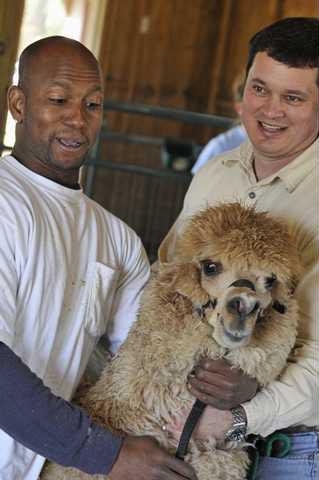Watch video of Alpaca shearing:
The odd noises coming from Bill Brannen’s barn on Sinkhole Road Wednesday may truly have been moans of relief: about 25 alpacas were being relieved of their heavy winter coats in preparation for the upcoming heat of spring and summer.
It was shearing day at Ogeechee Alpacas, and the barn was a flutter of activity as a shearing team buzzed and Brannen’s friends and family bustled to remove fleece, administer medications and dewormer, trim hooves and take blood for DNA samples, which are required for registering the animals.
The animals are also microchipped.
What is an alpaca, anyway? A camelid (member of the camel family), alpacas are smaller than llamas and are raised primarily for their exquisite fleece, which is transformed into a high quality yarn, Brannen said.
But the gentle animals also make good companion animals and can be shown as well.
Brannen has been raising alpacas since 2004, after he visited an alpaca farm out of curiosity. He had seen advertisements and wondered whether the animals would be suitable for his small farm, and discovered with delight that they were. “They just clicked with me,” he said. “They’re easygoing, tranquil animals. It’s relaxing to be around them.”
Even with the noisy activity of shearing, the alpacas weren’t overly disturbed. Helpers would catch one, lead it to the shearing mat, and gently lay it down where it was restrained during the shearing.
Peter Connelly, owner of Pura Vida Alpaca Shearing out of Colorado, quickly and efficiently shaved the fleeces off the alpacas, removing the larger portion of fleece from the body in what appeared to be a blanket, soft to the touch.
How does one become an alpaca shearer? Connelly, a former writer, fell in love with the animals after helping a neighbor with his herd. He was at an alpaca show to write a story about the event when he met David Carrell, a shearer from Monroe, Ga., and helped him shear one of the animals.
The interest blossomed, Connelly kept in touch with Carrell and now he travels from Florida to Idaho each spring, as shearing season lasts from March to June, he said.
Brannen said the alpaca fleece is in demand for fine quality clothing and has much of his fleece spun into yarn, which is then made into clothing for his family, he said. Other fleece is sold.
Alpacas weigh anywhere from 120 to 160 pounds at adulthood, and cost up to $500,000, depending upon quality, he said. Pet quality geldings (neutered males) can be purchased for as low as $250, but a breeding female usually costs anywhere between $8,000 and $15,000, he said.
As the fleeces were removed, Brannen’s family and friends gathered the soft fiber and placed it in bags, separating the body fleece from that of the rest, as the quality is different.
Other helpers labeled bags containing DNA samples, administered medicines and dewormer, and Brannen himself used a set of clippers to trim the alpaca’s cloven hooves, which are not completely hard like those of cattle or horses, but consist of a softer pad surrounded by a harder surface.
And in the midst of the flurry of activity, life went on; a newborn cria, which is what baby alpacas are called, lay in the sunshine next to its mama, born that very morning.
Holli Deal Bragg may be reached at (912) 489-9414.

